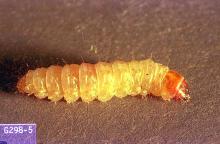Synanthedon sequoiae
Pest description and crop damage The adult moth is clear-winged with yellow and black markings resembling yellow-jacket wasps. The larvae are about 1 inch long, yellowish, with a reddish brown head.
The larvae of the sequoia pitch moth feed by boring into branches or trunks. At the point where the larva enters the wood, small to large masses of white to pinkish pitch accumulate. The larva feeds locally underneath the pitch mass. This pest causes mainly aesthetic damage because of the pitch masses. Incidentally, they do not attack Sequoia, the coast redwood.
Biology and life history Eggs are laid on the bark of host trees. The larvae bore into the inner bark and establish a feeding site. The feeding site can be distinguished easily by the large accumulation of pitch and frass on the exterior of the bark. Pupation takes place within this mass, and the adult moths fly in summer. About half the population completes its life cycle in 1 year; the other half requires 2 years.
Sampling and thresholds A pheromone trap is available to time adult activity.
Management-cultural control
Healthy trees are not commonly attacked. Infestations often are associated with pruning wounds or mechanical damage to the tree. Trees which are wounded in the spring and summer when adult moths are flying are far more likely to be attacked than those pruned or injured in the fall and winter. The moths also may be attracted to trees undergoing stresses associated with drought or saturated soil. Remove pitch masses by hand.
Management-chemical control
See:
Chemical Control of Nursery Pests
Apply materials to the trunk and lower limbs. Avoid contacting foliage.
For more information
Johnson, W.T. and H.H. Lyon (1991), Insects That Feed on Trees and Shrubs, 2nd ed., Cornell University Press (p. 72).
PNW Nursery IPM: Sequoia pitch moth (http://oregonstate.edu/dept/nurspest/sequoiapitchmoth.htm)




